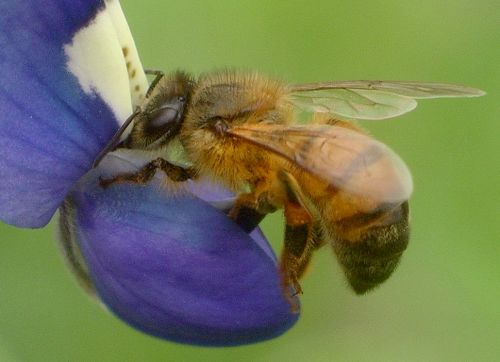by Valerie
January, 2011Honey Bee
Whole books have been written about the honey bee (Apis mellifera), but it is sometimes surprising how little most people know about this ubiquitous garden visitor. As one of our most economically important insects, it is no wonder that they have been studied so intensely. They pollinate many of our crops and produce beeswax and honey. They are, however, not native to North America. The first European settlers brought them along, considering them as useful as cattle and poultry. Honey bees have been in the news a lot recently due to a decline in many of the commercially managed populations. The reasons seem to be complex and multiple: attacks by varroa mites, inbreeding of commercial stock, outbreaks of diseases, and pesticide use. Here in Austin, feral honey bee colonies can occur in trees, peoples' homes, and smaller structures such as bird nesting boxes and mailboxes. These should always be treated with caution because they might contain Africanized bees (a more aggressive strain of the same species) which tend to attack more readily and with more energy. There are a good number of bees that can be found visiting flowers in our area, and they are not all honey bees. Identifying bees can be a little confusing, especially because honey bees are variable in their color; some are orange while others might be darker or more tan. The pollen visible on their legs will vary in color as well, depending on what kinds of flowers they have been visiting. Other bees that are about the same size and shape as honey bees include leaf-cutter bees, mining bees, and digger bees, many of which are solitary instead of social. Honey bees, though, are intensely social, living in hives that contain a queen and her daughters (the workers). Males and new queens are produced just once a year. Hives endure for years, in part because the workers regulate the temperature inside, keeping it warmer in the winter and cooler in the summer. The sting of honey bees is well known to most people. What is not usually realized is that the stinging individual will die because damage to other vital parts occurs as the stinger pulls out of her body, along with a sac of venom that continues to pump even after it is left behind. Our native bees do not have this fatal result and can sting multiple times without damage to themselves. Luckily, they are very unlikely to sting, though, because they do not have a hive to defend. One interesting aspect of honey bees' social behavior is that they can communicate locations of nectar and pollen sources, as well as water, to their sisters back at the hive. It is always evident where the best blossoms are at any given time, because they will be buzzing with scores of honey bees. |